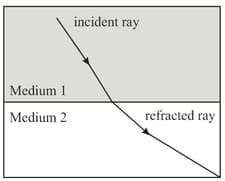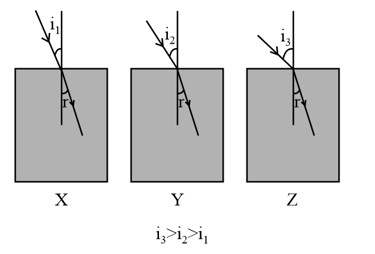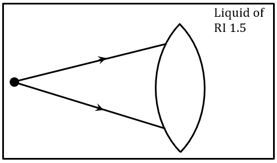NCERT Solutions for Chapter: Light - Reflection and Refraction, Exercise 1: Exercise
NCERT Science Solutions for Exercise - NCERT Solutions for Chapter: Light - Reflection and Refraction, Exercise 1: Exercise
Attempt the practice questions on Chapter 10: Light - Reflection and Refraction, Exercise 1: Exercise with hints and solutions to strengthen your understanding. Science Textbook of Competency Based Questions for Class X solutions are prepared by Experienced Embibe Experts.
Questions from NCERT Solutions for Chapter: Light - Reflection and Refraction, Exercise 1: Exercise with Hints & Solutions
Solar cookers contain a concave mirror. How does the concave mirror help in heating the food?
A mirror magnifies the image of an object by times. Which of the following is true about the image produced by the mirror?
The picture shows the path of light as it travels from one medium to another.

What is medium 1 and medium 2?
The power of a lens is calculated by the formula: , where is the focal length of the lens. A lens has a focal length of . Is it a convex lens or a concave lens? Explain your answer.
The images formed by an ordinary convex lens suffer from a defect, called chromatic defect, which leads to false coloured edges in the images. This happens because light rays of different colours bend differently as they enter and leave the lens.
If a parallel white light beam passes through a convex lens, the light of which colour (among violet to red in the spectrum) will converge at a point closest to the lens? Justify your answer.
Smriti is looking at herself in a convex mirror in a science museum, standing away from the mirror. Her image appears to be around half her actual height. Estimate the focal length of the mirror.
A lens made of material with a refractive index is immersed in a liquid with a refractive index . The diagram below shows two rays incident on the lens when it is immersed in the liquid.
Copy the diagram and draw the light rays after they pass through the lens. Justify your diagram.
The image below shows the refraction of light in three transparent rectangular blocks, X, Y and Z, made of different materials when they are placed in air. The angle of incidence is different in each case but the angle of refraction is the same in all three blocks.

Compare the speed of light in the three blocks. Justify your answer.

